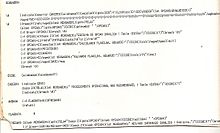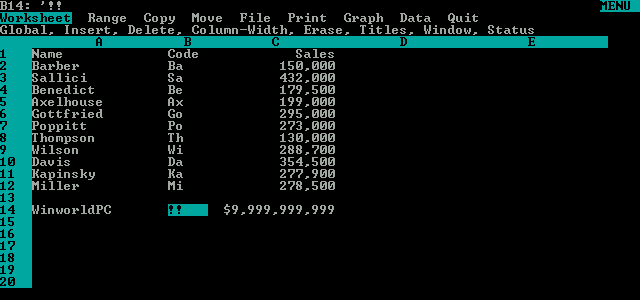The 123 file extension is associated with Lotus 1-2-3, a highly popular spreadsheet program sold by IBM in mids 80s. It was eventually discontinued when Excel took its dominant place on the market. The 123 files were used by some versions of Lotus 1-2-3 for their saved spreadsheets. Here is hcmort.wks a very basic Lotus 123 compatible spreadsheet following the example above. Just about every spreadsheet made by mankind (and Microsoft too!) will accept WKS format spreadsheets. See if this works for you. This example above uses the Excel version of PMT. Yours may differ. Download Lotus 1 2 3 Mac Software. Enterprise Architect for UML 2.3 v.9 Enterprise Architect is a flexible, complete and powerful UML 2.3 modeling tool for Windows Mac. Platforms (.via crossover). Lotus 1-2-3 was an early spreadsheet application available for MS-DOS. It became extremely popular in the late 1980s, displacing the former leader VisiCalc. Lotus had difficulties adapting 1-2-3 to the Windows environment, and was overtaken by Microsoft Excel. Spreadsheet functionality was also included in Lotus Symphony. Later versions were included in Lotus SmartSuite. Now the Lotus Notes is downloaded and installed in the local machine and configure IBM Lotus Notes with the email account. When the configuration is finished you will able to store your emails, maintain an address book and create a calendar event and also it helps you to Convert NSF to PST and Lotus Notes to Office 365 migration using our products.
Lotus 1-2-3 was the killer app that made the IBM PC the standard for computers. It wasn’t the first spreadsheet, but it ran on a computer that could easily address more than 64K of memory, it was fast, and relatively bug free. So it was super successful. Today we know it as the thing people used before Excel. So what were the advantages and disadvantages of Lotus 1-2-3?
Advantages of Lotus 1-2-3
In its heyday, Lotus 1-2-3 was fast. It ran on IBM PCs and it pushed their limits. If you knew how to use Visicalc, you could move to 1-2-3 pretty easily, and the PCs were quicker than the 8-bit Apples that ran Visicalc. Aside from being a spreadsheet, it had built in graphing, and you could use it as a rudimentary database. There wasn’t much that Excel did that 1-2-3 didn’t, but 1-2-3 was doing it before Windows existed.
In the 1980s, 1-2-3 was the reason a lot of people bought IBM-compatible PCs. They’d go buy the cheapest clone they could find, like a Leading Edge Model D or something similar, then they’d pay a few hundred dollars for a copy of 1-2-3. Or they’d buy the PC and pirate 1-2-3.
In those early days, Lotus drove the industry. When 640K of memory was no longer enough, Lotus helped invent a workaround that allowed PCs to use more. Microsoft called it expanded memory or EMS, but most of the industry called it LIM, for Lotus-Intel-Microsoft, the three companies who collaborated on it. A lot of DOS games used it too, but originally it existed to give Lotus 1-2-3 more memory so it could crunch bigger spreadsheets.
Lotus made a lot of products, but 1-2-3 was its biggest product in the early days. When someone said they knew “Lotus,” they were referring to 1-2-3.
Enter the Excel juggernaut
There’s just no way around it. Lotus frittered away its market leadership. When the Mac came out, Lotus built a Microsoft Works-like integrated package for it that combined a so-so word processor, a so-so spreadsheet, and a so-so database. They called it Jazz and expected it to become a killer app. It flopped. Meanwhile, there was Microsoft. Microsoft had an also-ran spreadsheet called Multiplan that ran on PCs. They decided to make a full-featured, easy-to-use spreadsheet on the Mac and called it Excel. People skipped Jazz and flocked to Excel.
Then, in the second half of the 1980s, Microsoft released this thing called Windows. Nobody wanted it because it was slow and crashed a lot. But they wrote a version of Excel for Windows too. Lotus built a souped-up 1-2-3 for an IBM operating system called OS/2 that about twelve people liked. I was one of them. They ignored Windows. In 1990 when Microsoft finally got Windows to a point where you could run it for four hours without it crashing, Excel was one of the few native programs you could run on it. It was just as easy to use as it was on the Mac, and you could run it on a $995 286 clone you bought at the nearest consumer electronics store.
The combination of ubiquitous cheap PCs bundled with Windows and Mac-like software to run on it proved unstoppable.


Lotus 123 For Macbook Pro

Disadvantages of Lotus 1-2-3
Lotus 123 For Mac
There wasn’t necessarily anything wrong with Lotus 1-2-3 in 1990, except it ran on DOS. Excel on Windows was easier to use. 1-2-3 had a complex menu structure while Excel had a toolbar with nifty icons for the most commonly used functions. If you’d never used Lotus 1-2-3 before, you had to buy a book to learn it. You could fumble your way through Excel without a book.
Lotus eventually wrote a version of 1-2-3 for Windows and it worked fine, but Excel was the standard by then. If you used DOS, you ran Lotus. If you used Windows, you ran Excel. The exception was if you were a holdout and you had been running 1-2-3 on DOS for years. Then you might opt for 1-2-3 for Windows. But outside of the accounting department, you didn’t find very many of those people.
Then, in 1995, along came Windows 95, a 32-bit Windows for mainstream computing. Microsoft released a native 32-bit version of Excel the very same day. It took Lotus about two years to release a 32-bit version of 1-2-3. The 16-bit version of 1-2-3 was a little bit faster than those early 32-bit versions of Excel, but Excel was more stable and you could load much bigger spreadsheets on it. And by the time Lotus shipped its first 32-bit version of 1-2-3, it was competing with Microsoft’s second 32-bit version of Excel.
Lotus 123 Macro Examples
IBM bought Lotus in 1998, and updated 1-2-3 a few times, but gave up on releasing new versions in 2002. They sold the old version to die-hards until 2013, but it was a niche product by then.
Lotus 123 Software For Mac
There wasn’t anything inherently wrong with 1-2-3 on Windows except it was always a couple of years behind Microsoft. And people weren’t going to wait for Lotus to catch up.



